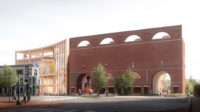Design of Chipperfield-led Expansion of National Archaeological Museum Unveiled in Athens




Flowing exhibition space with diagonal views. Rendering © Filippo Bolognese Images

New entrance to the museum. © Filippo Bolognese Images





Architects & Firms
Surrounded by demonstrations against the increasing liberalization of Greece’s museums, Prime Minister Kyriakos Mitsotakis unveiled David Chipperfield’s winning design to expand the National Archaeological Museum (NAM) in Athens. The prime minister has made culture one of the key pillars of his offering for re-election in July and has been negotiating with the British Museum—so far unsuccessfully—for the return of the Elgin Marbles, which could be hosted in the new building. As he announced the extension, Mitsotakis had just guided controversial legislation through the Hellenic Parliament reorganizing the governance of Greece’s museums. He said Chipperfield’s “inspiring” design allowed him to achieve a “life-long ambition to expand the museum.”

Central courtyard connecting the old and the new Rendering © Filippo Bolognese Images
The winning proposal by David Chipperfield Architects’ Berlin office in collaboration with local practice Tombazis & Associates Architects will connect the beautiful but aloof 19th-century neoclassical museum to Patission Street, a main thoroughfare, with a new 210,000-square-foot structure which will sit largely below the existing grade. Structurally, it will be made from rammed clay that will be left exposed in key spaces. This submerged building will then be covered with a new city park, replacing the desultory existing gardens. The aim, according to Chipperfield, is to bring the museum, until now withdrawn from the street, into contact with civic life. In addition to extra ticketing space and improved accessibility, the project will “create a seductive landscape of galleries… It’s about bringing the collection to the street, not just the museum,” said Chipperfield at the Athens unveiling.

Enclosed exhibition space Rendering © Filippo Bolognese Images
The new building, which effectively acts as a double basement underneath the access apron of the existing museum, will be divided into two wings. The extension will be organized around a recessed central courtyard which will grant views to the original facade and allow access to the old building up a grand staircase, as it is currently. Although no curatorial decisions have yet to be made, works such as the Parian marble statue of Poseidon, created circa 100 BCE and discovered in Melos, currently stand in cramped conditions and can be afforded more space. Other parts of NAM’s collection that have not yet been exhibited will also be given a home.
Museum officials hope that subterranean links between the original museum building and the new structure—with the Wirtz International–designed park on its roof—will ensure that the extension will feel like part of the whole museum experience and not just a particularly grand entrance space.
The Chipperfield-designed addition to NAM is politicized. Mitsotakis will stand for re-election in July and opposition to his New Democracy party made their displeasure at the new legal freedoms being granted to museums known at the unveiling, claiming the move to be a financialization of Greek culture. By allowing museums to exist independently from the Ministry of Culture and by permitting expertise from outside the archaeological profession to determine museum leadership, Mitsotakis, who has an MBA from Harvard Business School, hopes to encourage tourism, which has rebounded under his leadership following COVID-related shutdowns.
Within the Mitsotakis government there is the belief that the NAM expansion will not so much increase visitor numbers in Athens but extend the length of time that the huge number of tourists spend in the Greek capital. Currently, visitors to Athens are drawn almost exclusively to the Acropolis and the nearby Acropolis Museum, designed by Bernard Tschumi, which opened in 2009.

Spaces around the central courtyard Rendering © Filippo Bolognese Images
“The city is interested in attracting slightly longer stays [and] more serious visitors than the one-day cruise ship brigade,” Chipperfield said.
His design for an expanded and more accessible NAM appears to be a positive, if subtle, way to give an institution with a rich collection the opportunity to offer more.




